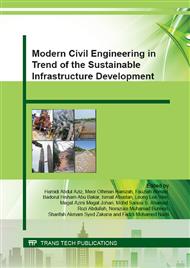p.605
p.611
p.617
p.623
p.629
p.634
p.640
p.649
p.655
Subsurface Characterization Using Ground and Underwater Resistivity Techniques for Groundwater Abstraction
Abstract:
A geophysical method was used in studying the subsurface profile for investigating the aquifer existence at Jenderam Hilir, Selangor, Malaysia. The 2-D electrical resistivity technique is to determine the presence of aquifer suitable for groundwater abstraction. Resistivity was measured through an ABEM SAS 4000 Terrameter and ABEM Terrameter LS. 2-D electrical-imaging resistivity data of subsurface profile for each survey line were calculated inverse modelling, validate by borehole data which showed the lithology: sandy clay to sandy silt sediments more than 3 m deep, composed of alternating layers of silty and sand. The aquifer potential are mostly in silty sand zones which resistivity value should be within 60-800 ohm-m. Based on interpretation, a potential water-bearing aquifer was located at a depth of 3 m and below which is good agreement with interpreted results. 2-D underwater resistivity survey lines were conducted across the ground and river. Resistivity image was interpreted as silty sand under the river bed, which the subsurface aquifer on land has a physical contact with surface water. Result has shown that ground and underwater resistivity technique can be used as alternative method in finding a good location for groundwater abstraction.
Info:
Periodical:
Pages:
629-633
Citation:
Online since:
October 2015
Keywords:
Price:
Сopyright:
© 2015 Trans Tech Publications Ltd. All Rights Reserved
Share:
Citation:


